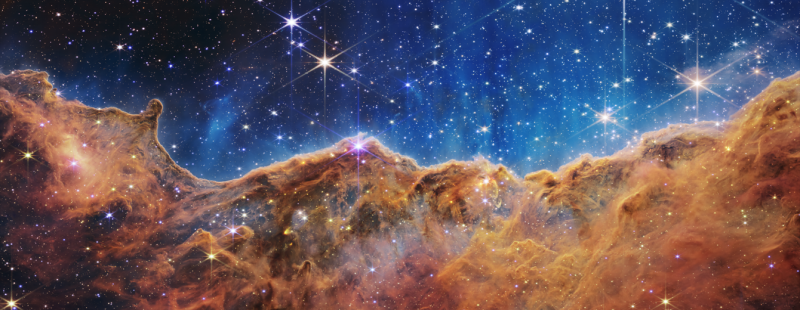I’ve been reading recently about NASA’s new James Webb space telescope. It was launched last December, set in a stationary orbit somewhere past our moon, and it has the unique property of being infrared-capable, which its predecessor, Hubble, was not. This infrared capability, combined with its celestial location, matters to astronomers and space-peering scientists because exoplanets—the ones outside our solar system—are dimmer than their surrounding stars except in the infrared spectrum, which poorly penetrates Earth’s atmosphere. And finding exoplanets increases our chances of finding a habitable one, which it is starting to seem like something we might need sooner rather than later.
But what caught my attention was the story behind the telescope and its convoluted, four-decade path to its home. The idea for such a telescope was conceived back in 1996 when a pair of Swiss astronomers confirmed the existence of an exoplanet orbiting a solar-type star. NASA recognized its importance and began planning the James Webb project with a tentative launch date in 2007. By 2010, not only were they 3 years late but also ten times over budget. Same thing happened with 2015, then 2017, and then COVID-19 put everything on hold. And at every delay, someone was there to question the usefulness of the project or to insist it would never work as planned.
This matters to me because, as a transfer student to Stanford, I am familiar with delays and long, drawn-out processes. I earned my first college credits in 2009 through a credit-by-exam program that I had studied for while sitting on an ammo can between patrols on my first deployment with the Navy. I started online classes in 2014, have been a matriculated student in four schools across the country and will finally confer my bachelor’s degree this fall of 2022. And my transfer peers have similar stories. Some began their studies half a decade ago while in prison; in their forties, already single parents; after music careers; after retiring from the military; or after a decade dancing in the Royal Ballet, and so on with any permutation of life you can imagine.
This fall, we got a few more transfers, each with their own story. And if you ask me, they couldn’t be coming at a more needed time. Because last July, while James Webb was beaming back its first pictures of dazzling galaxy clusters and deep-purple nebulae, a comet the size of two Mount Everests crossed Earth’s orbit. The comet that killed the dinosaurs was only one Mount Everest. Rainforest fires are raging, Earth’s ocean heartbeat is weakening, and the battle goes on for No More Names, for education and empowerment of every citizen, for freedom for every human of minds, bodies, and love.
And I wonder sometimes if it seems that these struggles were always there or always will be. That we are always one disaster or one maniac away from extinction or total degradation of humanity. Perhaps that is because we are. Which is why the world will always need people who are willing to be different, to fight for what they love, to stand in the gate, the parapet, or the lone watchtower on the mountain, armed with the sword and shield that is unique to them, to hold out for the rainbow at the other end of a long storm.
Of course, as a transfer student, it will not be easy. You might stare at screens of hieroglyphic-looking symbols, wondering if you’ll ever understand them, or cross the Quad alone on a cold, raining night, wondering if you belong—to Stanford or to the world. To these, unfortunately, I have no answer except “be patient,” and “maybe no one does.”
“There may be more beautiful times,” Jean-Paul Sartre wrote, “But this one is ours.” And it may be, from a cosmic perspective, that we’re only glitches in the void, specks of animated molecules on a speck of a rock, vapors at the capillary tips of a water-covered world. Perhaps the singularity 14 billion years ago collapsed by chance; hydrogen collected in gravitational pools by chance, generations of stars lived, died, and exploded their raw materials into space by chance; perhaps lightning crackled life into ammonia pools, or amino acids formed near sub-oceanic thermal vents, and dolphins, chimpanzees, butterflies and humans evolved from them, all by chance. But by that chance, we’re here.
So thank you for being here, for living in these times, for taking the chance that there is something to fight for. Of course this is for more than just Stanford transfers. Thank you to every parent who loves their child, to every person whose inner child plays in the rain at the sound of thunder, to anyone who has followed a purpose they cannot quite describe with means they are not sure they have. “If you’ve managed to do one good thing,” poet Ellen Bass writes, “the ocean doesn’t care. But when Newton’s apple fell toward the earth, the earth, ever so slightly, fell toward the apple as well.”
